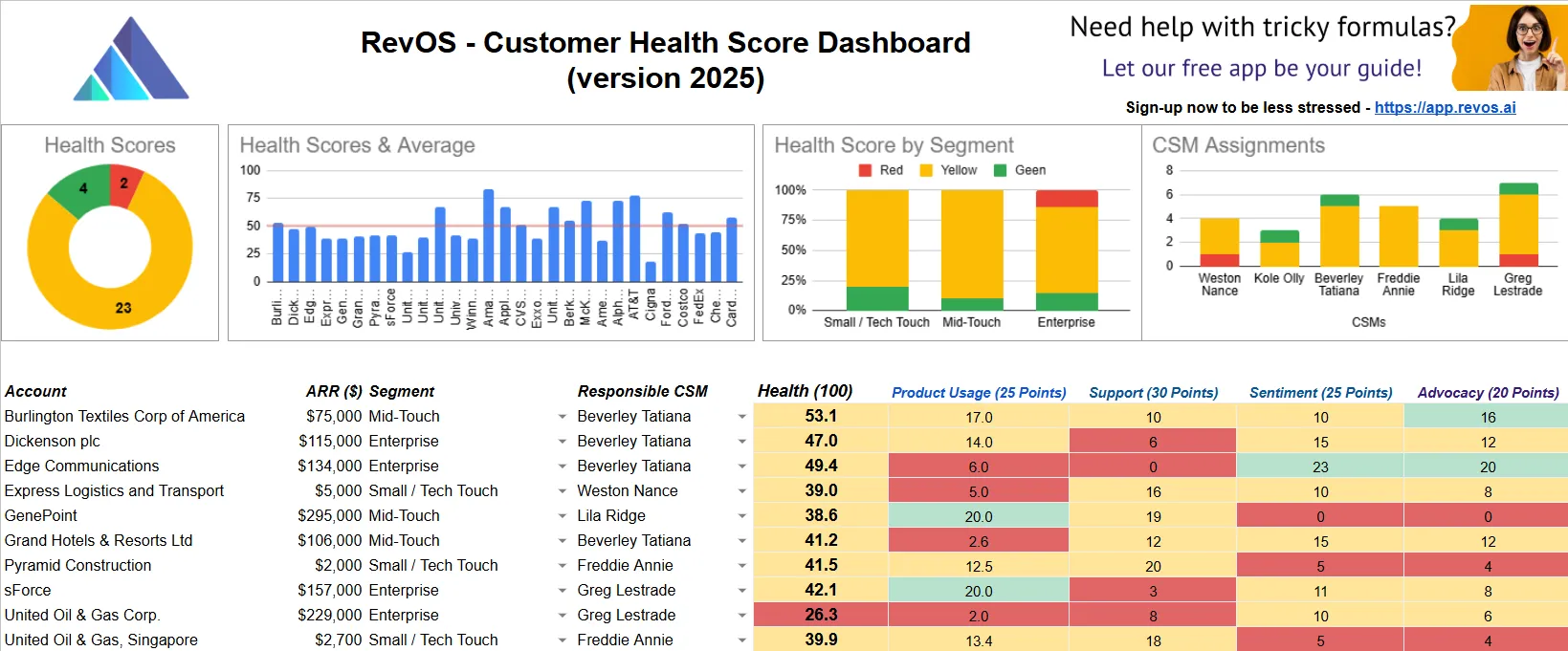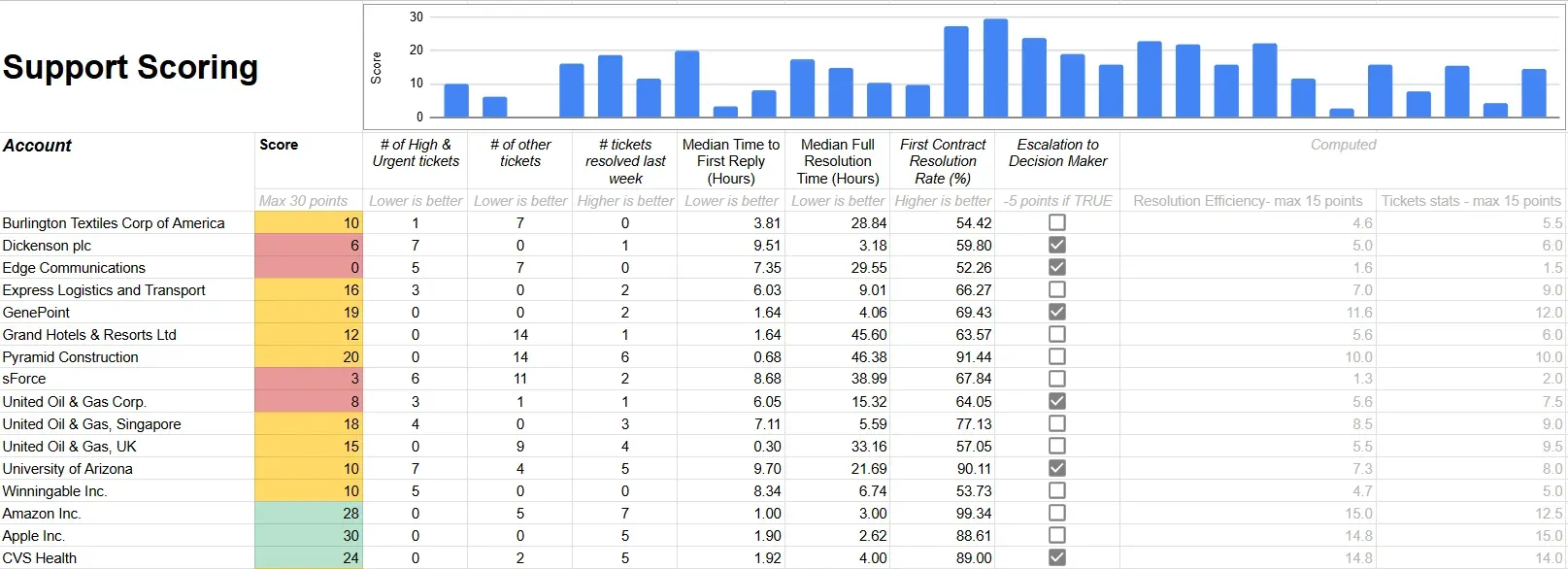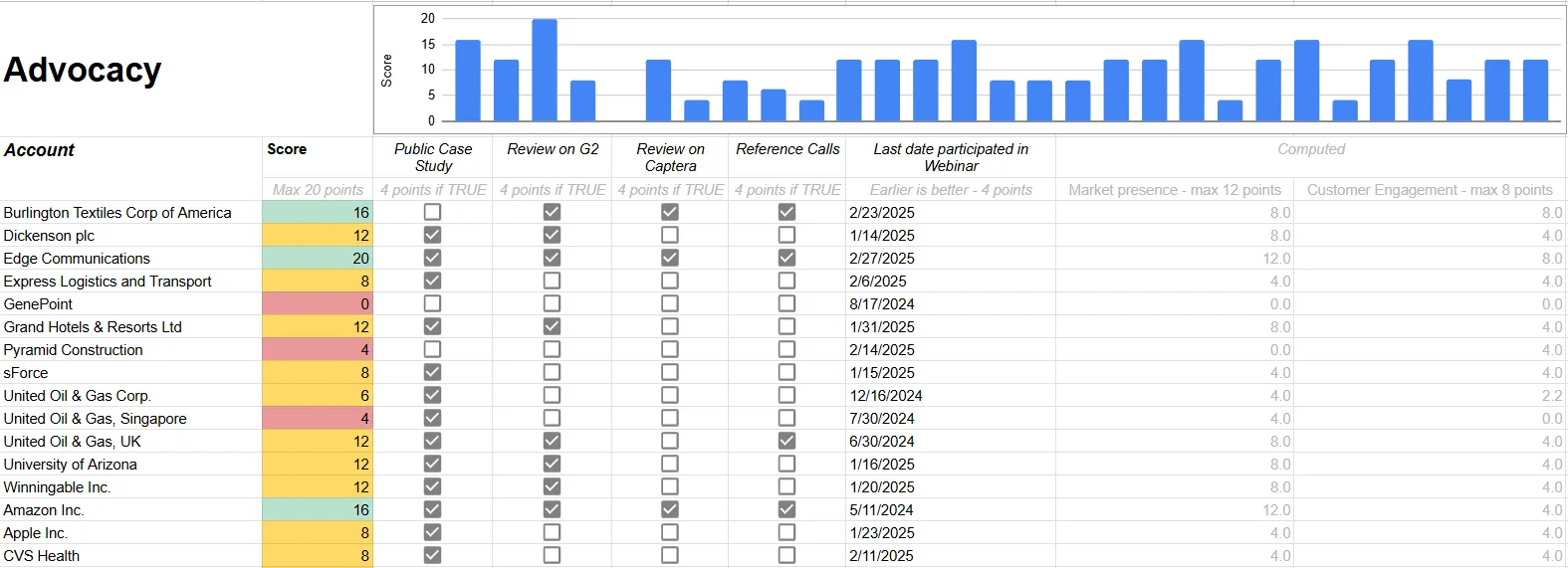Customer Health Scoring update 2025
 Renat Zubayrov
Renat ZubayrovLast year, our Customer Health Score Template was an enormous success, with thousands of downloads globally and widespread daily usage across various industries. Thanks to an overwhelming wave of feedback and an extensive evaluation of tens of millions of data points collected on the RevOS platform over the past year, we're thrilled to roll out our most exciting and advanced update to the Customer Health Score Template yet.
Incorporating over 450 community-driven suggestions and enhancements inspired by top-tier organizations like Apple, IBM, Google, and Wolterskluwer, this latest version offers simplified setup, enhanced customization, and more robust predictive capabilities, enabling businesses to proactively manage customer success more effectively than ever.
Latest version features a simplified setup, enhanced customization, and more robust predictive capabilities, enabling businesses to proactively manage customer success more effectively than ever.
2025 Trends and Recommendations for Customer Health Scoring
Before diving into the specifics of the 2025 updates, it's valuable to highlight some key learnings and emerging trends we've observed in predictive scoring.
To begin, high-quality data remains paramount. Companies and teams that diligently maintain accurate, consistent, and timely data in their CRM systems are significantly better positioned to make effective, data-driven decisions. Quality data not only enhances predictive accuracy but also enables proactive strategies, giving businesses a competitive advantage.
It's crucial to ensure your customer health score drives actionable insights. Many health scores fail because they're disconnected from meaningful actions. Selecting KPIs should always involve asking, "What specific actions can we take to impact this KPI?" ensuring that your scores remain practical, relevant, and effective.
Ensuring relevance involves carefully aligning customer health scores with tangible business outcomes. Many health scores fail to deliver expected results because they're not closely connected to actual business objectives, reducing their effectiveness and negatively impacting the return on investment. By clearly linking health scores to critical business metrics like growth, profitability, and customer satisfaction, businesses can ensure their activities have a meaningful impact, maximizing strategic value and ROI.
A well-constructed health score is validated through historical data, grounded in the past experiences of your team, and proven through past performance. For example, consistently declining product usage patterns historically predict higher churn rates, while frequent engagement with support resources can indicate an emerging issue that proactive measures could resolve. Historical data validation not only strengthens reliability but enhances predictability, making your health scores a trustworthy guide for future strategic decisions.
Simplicity is essential for effective health scoring. Often, teams create overly specific or complicated scoring models that are difficult to communicate and understand, much like 'over-fitting' in machine learning. A simpler approach, starting with 6 to 10 carefully selected KPIs grouped into 2-3 intuitive categories, generally provides greater clarity, usability, and effectiveness. This streamlined method makes the health score easier to interpret, implement, and refine over time, ensuring better alignment and adoption across teams.
Deep Dive into Updated Template Sections
Overview Page / Dashboard
The Overview Page serves as the central hub for tracking customer health, consolidating insights from all four scoring categories—Product Usage, Support, Sentiment, and Advocacy—into a single, actionable metric. This dashboard enables teams to quickly assess overall customer engagement, identify risks, and prioritize accounts for intervention.

Dashboard details
- Comprehensive Customer Health Score (Max 100 Points)
- Segmented Analysis for Targeted Strategies
- CSM Assignments and Workload Distribution
Understanding how customers engage with your product is essential for proactive customer success management. Product usage scoring allows businesses to assess adoption levels objectively, regardless of company size, by normalizing key metrics.

Why Product Usage Matters
- Utilization Reflects True Engagement
- Feature Adoption Indicates Value Realization
- Integrations Drive Stickiness
A strong support experience is a key pillar of customer success, ensuring that users receive timely and effective resolutions to their issues. The updated Support Scoring methodology evaluates customer interactions based on two fundamental groups of KPIs: Resolution Efficiency and Tickets Stats, while also accounting for escalations as a negative factor.

Why Support Scoring Matters
- Resolution Efficiency Measures Support Quality
- Ticket Stats Identify Support Demand & Risk
- Escalation Markers Highlight Critical Issues
Understanding customer sentiment is crucial for long-term success. The updated Sentiment Scoring model evaluates how engaged and connected customers are with your business, ensuring a proactive approach to relationship management. This score is built from three key components: Customer Contacts, QBR Engagement, and Escalation Impact.

Why Sentiment Scoring Matters
- Customer Contacts Reflect Relationship Strength
- QBR Engagement Shows Long-Term Interest
- Escalation Signals Dissatisfaction
Advocacy is a strong indicator of customer commitment and long-term satisfaction. This scoring model measures how actively customers promote your product and engage with your brand. It consists of two key components: Market Presence and Customer Engagement.

Why Advocacy Scoring Matters
- Market Presence Reflects External Influence
- Customer Engagement Shows Ongoing Interest
Next Steps:
Download the Updated Template and Explore Automated Insights
- Simple steps to download and start using the updated template immediately
- Benefits of transitioning from manual to automated health scoring
- Introduction to our app with automatic data connectivity, real-time updates, and actionable insights
- Offer a free trial/demo to experience automation firsthand
- Invite readers to share feedback for ongoing improvements
Read more about revenue operations, growth strategies, and metrics in our blog and follow us on LinkedIn, Youtube, and Facebook.
← Go back to blog